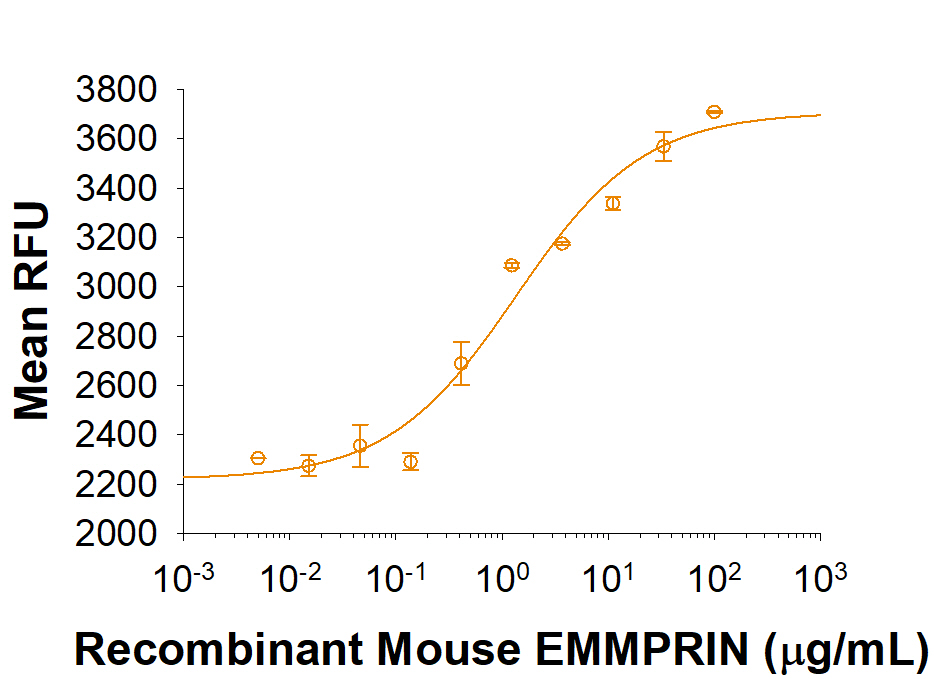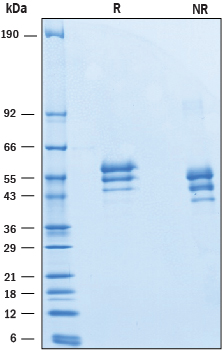Recombinant Mouse EMMPRIN/CD147 His-tag Protein, CF Summary
Product Specifications
Ala22-Arg325, with a C-terminal 6-His tag
Analysis
Product Datasheets
Carrier Free
CF stands for Carrier Free (CF). We typically add Bovine Serum Albumin (BSA) as a carrier protein to our recombinant proteins. Adding a carrier protein enhances protein stability, increases shelf-life, and allows the recombinant protein to be stored at a more dilute concentration. The carrier free version does not contain BSA.
In general, we advise purchasing the recombinant protein with BSA for use in cell or tissue culture, or as an ELISA standard. In contrast, the carrier free protein is recommended for applications, in which the presence of BSA could interfere.
772-EM
| Formulation | Lyophilized from a 0.2 μm filtered solution in PBS. |
| Reconstitution | Reconstitute at 500 μg/mL in PBS. |
| Shipping | The product is shipped at ambient temperature. Upon receipt, store it immediately at the temperature recommended below. |
| Stability & Storage: |
|
Scientific Data
 View Larger
View Larger
Recombinant Mouse EMMPRIN/CD147 induces NHLF human normal lung fibroblasts active MMP-1 secretion. The ED50 for this effect is 0.6-4.8 μg/mL.
 View Larger
View Larger
2 μg/lane of Recombinant Mouse EMMPRIN/CD147 was resolved with SDS-PAGE under reducing (R) and non-reducing (NR) conditions and visualized by Coomassie® Blue staining, showing bands at 43-66 kDa.
Reconstitution Calculator
Background: EMMPRIN/CD147
Extracellular matrix metalloproteinase (MMP) inducer (EMMPRIN), also known as basigin, membrane glycoprotein gp42, and CD147, is a 45-55 kDa, N-glycosylated type 1 transmembrane molecule which is categorized as a member of immunoglobulin superfamily (1-4). Mouse EMMPRIN is 389 amino acid (aa) in length and contains 21 aa signal sequence, 304 aa extracellular domain (ECD), 24 aa transmembrane (TM) segment, and 40 aa cytoplasmic tail (CT). The ECD contains one C2‑type and one V-type Ig-like domain. EMMPRIN is expressed in areas of tissue remodeling, including endometrium, placenta, skin, and regions undergoing angiogenesis (1, 2, 5, 6). It is also expressed on cells with high metabolic activity, such as lymphoblasts, macrophages and particularly tumor cells (2, 7). On such cells, EMMPRIN is often co-expressed with the amino acid transporter CD98h (8). EMMPRIN also interacts with caveolin1 (via its C2-type domain), and this reduces the level of EMMPRIN glycosylation and subsequent EMMPRIN multimerization and activity (9). In addition, EMMMPRIN is reported to complex with both annexin II and beta 1 integrins alpha 3 and alpha 6, an interaction that contributes to tumor growth and metastasis (10-12). Finally, the soluble calcium binding protein S100A9 has now been identified as a ligand for EMMPRIN, and it may mediate many of the tumorigenic activities attributed to EMMPRIN (13). EMMPRIN's TM sequence contains a charged aa (Glu), and a Pro important for intracellular interactions with cyclophilins (CyP) (3, 14, 15). CyPA (cyclosporin A receptor) and CyP60 interactions with the TM segment promote leukocyte inflammatory chemotaxis and surface expression of EMMPRIN, respectively (14, 15). An active 22 kDa fragment can be shed from tumor cells by MT1-MMP (1). Tumor cells can also release active, full length EMMPRIN in microvesicles (16, 17). EMMPRIN Plays an important role in targeting the monocarboxylate transporters SLC16A1, SLC16A3, SLC16A8 and SLC16A11 to the plasma membrane. It also plays pivotal roles in spermatogenesis, embryo implantation, neural network formation and tumor progression. EMMPRIN stimulates adjacent fibroblasts to produce matrix metallo-proteinases (MMPS) and seems to be a receptor for oligomannosidic glycans. In vitro, it promotes outgrowth of astrocytic processes (18, 19). Finally, EMMPRIN is known to induce urokinase type plasminogen activator (uPA), VEGF, hyaluronan and multiple MMPs (1, 2, 6).
- Gabison, E. E. et al. (2005) Biochimie 87:361.
- Yurchenko, V. et al. (2006) Immunology 117:301.
- Kasinrerk, W. et al. (1992) J. Immunol. 149:847.
- Iacono, K.T. et al. (2007) Exp. Mol. Pathol. 83:283.
- Riethdorf, S. et al. (2006) Int. J. Cancer 119:1800.
- Quemener, C. et al. (2007) Cancer Res. 67:9.
- Wilson, M. C. et al. (2005) J. Biol. Chem. 280:27213.
- Xu, D. and M. E. Hemler (2005) Mol. Cell. Proteomics 4:1061.
- Tang, W. et al. (2004) Mol. Biol. Cell 15:4043.
- Zhao, P. et al. (2010) Cancer Sci. 101:387.
- Dai, J. et al. (2009) BMC Cancer 9:337.
- Li, Y. et al. (2012) J. Biol. Chem. 287:4759.
- Hibino, T. et al. (2013) Cancer Res. 73:172.
- Arora, K. et al. (2005) J. Immunol. 175:517.
- Pushkarsky, T. et al. (2005) J. Biol. Chem. 280:27866.
- Egawa, N. et al. (2006) J. Biol. Chem. 281:37576.
- Sidhu, S. S. et al. (2004) Oncogene 23:956.
- Heller, M. et al. (2003) J. Neurochem. 84:557.
- Mannowetz N. et al. (2012) J. cell Physiol. 227:2154.
Citation for Recombinant Mouse EMMPRIN/CD147 His-tag Protein, CF
R&D Systems personnel manually curate a database that contains references using R&D Systems products. The data collected includes not only links to publications in PubMed, but also provides information about sample types, species, and experimental conditions.
1 Citation: Showing 1 - 1
-
Knocking-Down CD147/EMMPRIN Expression in CT26 Colon Carcinoma Forces the Cells into Cellular and Angiogenic Dormancy That Can Be Reversed by Interactions with Macrophages
Authors: G Feigelman, E Simanovich, P Brockmeyer, MA Rahat
Biomedicines, 2023-03-02;11(3):.
Species: Mouse
Sample Types: Whole Cells
Applications: Cell Culture
FAQs
No product specific FAQs exist for this product, however you may
View all Proteins and Enzyme FAQsReviews for Recombinant Mouse EMMPRIN/CD147 His-tag Protein, CF
There are currently no reviews for this product. Be the first to review Recombinant Mouse EMMPRIN/CD147 His-tag Protein, CF and earn rewards!
Have you used Recombinant Mouse EMMPRIN/CD147 His-tag Protein, CF?
Submit a review and receive an Amazon gift card.
$25/€18/£15/$25CAN/¥75 Yuan/¥2500 Yen for a review with an image
$10/€7/£6/$10 CAD/¥70 Yuan/¥1110 Yen for a review without an image
